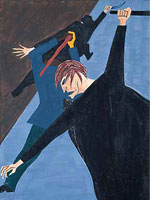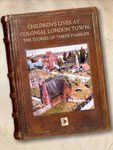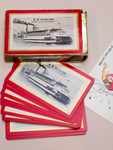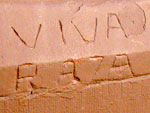Religion and the Labor Movement: A Guide for Pre-Service Teachers

What is it?
The history of the labor movement in the United States and the history of religion in the United States are two topics that are often taught, but rarely taught together. However, there are a number of compelling reasons to consider how they connect. Religious beliefs informed how Americans viewed their work and shaped how they thought employers ought to be treating them. Religious leaders at times supported organized labor’s efforts, while at other times sided with employers. At the same time, ideas about labor shaped Americans’ views of religion as the attitude of some churches toward labor demands put workers’ deeply held beliefs into conflict.
Key Points:
- This activity will take one 90-minute period or two 45-minute periods. It is appropriate for a high school U.S. history classroom, but can be modified for a variety of learners.
- Students will analyze, interpret, and evaluate primary sources.
- Students will learn about the American labor movement and how religion and culture affected political and social issues.
Approach to Topic
To facilitate students engaging in this history, a variety of Library of Congress primary sources from 1910-1920 will be used. It will be useful for students to have some background information on the labor movement at that time including the fight for the 8 hour work day, the 1886 Haymarket Affair, the 1892 Homestead Strike, the 1894 Pullman Strike. The Library of Congress has engaging resources on these topics on their website. A review in a standard history textbook would also be sufficient for this activity. The guide will also contain tips for teaching about religion generally to help teachers engage students with what can be a challenging topic to teach.
In introducing this topic to students, review briefly the effects of the industrial revolution on workers and the efforts by labor organizers to advocate for shorter working hours and safer working conditions. At the same time, communicate to students that the United States in the early twentieth century was a very religious nation and by this time it had become much more diverse in terms of religion with millions of Catholic immigrants from Ireland, Italy, Poland, and Hungary, Orthodox Christians from Greece, and Jewish immigrants from eastern Europe arriving in what had been a predominantly Protestant nation.
Description
This activity facilitates students’ engagement with primary sources as they explore the relationship between labor and religion in the United States in the early twentieth century. Students will examine sources carefully, note details, and then interpret what the details might mean based on what they know and their interpretations of the other sources. Students work together to create a brief multimedia presentation using two to three of the sources making the case that religion is shaping labor in this period or the opposite.
Teacher Preparation
Make the primary sources below available to students either through links, if using electronic devices, or by printing them out. According to your students’ needs, you may need to guide students to the relevant excerpts or share the excerpts separately. These excerpts are included below.
For presentations, a variety of formats might be used including PowerPoint, Google Slides, or Canva, are free to use or have free versions for teachers and students to use. Alternatively, teachers may have students create brief video presentations using iMovie or another video editing app or platform.
Differentiation note: Depending on students reading abilities, teachers may want to consider accommodations for engaging with the primary sources below. Excerpts from text sources have been included along with annotations to highlight the most relevant passages. Teachers may also elect to read excerpts out loud to students or to assign smaller chunks of texts for students to examine in small groups.
Primary sources
N.D. Cochran, “Is the Church the Best and Truest Friend Labor Ever Had?” The day book. September 05, 1913.
Note: Have students examine the front page of the source first. Then, depending on their reading level they can read through the article or read the excerpts below
Page 1: https://chroniclingamerica.loc.gov/lccn/sn83045487/1913-09-05/ed-1/seq-1/
Page 2: https://chroniclingamerica.loc.gov/lccn/sn83045487/1913-09-05/ed-1/seq-2/
Page 3: https://chroniclingamerica.loc.gov/lccn/sn83045487/1913-09-05/ed-1/seq-3/
Page 4: https://chroniclingamerica.loc.gov/lccn/sn83045487/1913-09-05/ed-1/seq-4/
Excerpt(s):
[From pages 2-3]
Yes, the head and founder of the church was a laboring man and He
chose laborers to help Him carry on his work. But He went forth to the
laborers and ministered to their physical wants as well as to their spiritual
needs. And the people loved and followed Him. He loved them and suffered for them.
The case of Cardinal Manning and the London dockworkers was an
isolated case, but it shows what the attitude of the church would be toward
labor if all-ministers practiced their Christianity as Cardinal Manning did.
And if that were the general attitude of the church toward labor the church
would be packed with laborers every Sunday. They would get acquainted
with the preacher during the week, when they were solving their daily
bread-and-butter problem.
But how many times has Rev. Mr. Lloyd gone to the workingmen in
their troubles and tendered his aid toward getting them justice?
How many ministers of the church took up the fight for justice and a
living wage for the clerks in Chicago department stores when the O'Hara
committee exposed the starvation wage policy of those stores?
How many ministers of the gospel even lifted up their voices in the
pulpit to help arouse a public sentiment that would insist on a decent living
wage for the department store clerks?
What ministers of the gospel went down into the loop last year to help
the striking newsboys and save them from the assaults of newspaper sluggers and policemen?
How many labor strikes have ministers investigated? How many have
they taken enough interest in to find whether the demands of the men were
just or unjust?
How will you make workingmen and women believe the church is the
ally of labor unless the church is with them in their most serious trouble
when they are striving for a living wage and a fair chance to feed, clothe,
house and educate their children?
I am asking these questions to be helpful, for I know something of what
is running through the minds of men who are struggling with all their
might to keep their heads above water in the fight for an existence.
I have talked with preachers about the “falling off” of church attendance.
I have talked with men and with women. I find no falling off of reverence
for religion or of love for the Christianity of Christ. So there is nothing the
matter with Christianity. It must be there is something the matter with
the church.
N.D. Cochran, “Why Rich and Poor Can’t Always Worship the Same God in the Same Church,” The day book. May 26, 1914.
Page 1: https://chroniclingamerica.loc.gov/lccn/sn83045487/1914-05-26/ed-1/seq-1/
Page 2: https://chroniclingamerica.loc.gov/lccn/sn83045487/1914-05-26/ed-1/seq-2/
Page 3: https://chroniclingamerica.loc.gov/lccn/sn83045487/1914-05-26/ed-1/seq-3/
Page 4: https://chroniclingamerica.loc.gov/lccn/sn83045487/1914-05-26/ed-1/seq-4/
Excerpt(s):
[From pages 2-3]
My own notion is that the main trouble with our churches is much the same as the main trouble with many of our newspapers; and that is, too much editing from the business office.
I mean by that, too much commercialization the wealthy pew renter being too influential in the church, just as the big advertiser is too influential with the newspaper; and the common people, and their everyday life problems, receiving too little sympathetic attention.
The attitude of "the burning bush" toward labor unions cannot be said fairly to be the attitude of the churches, for the general church attitude is not openly hostile, and varies with the convictions and courage of the individual ministers. Some are openly friendly. Others are more neglectful than openly hostile. They don't understand their Christianity, and while they preach beautiful sermons on Sunday, they have, to hump themselves the other six days of the week as ministerial business men, raising money to build a new church or pay off the debt on the old one; and in the meantime trying to keep alive on a beggarly wage, which is oozed out to them by a stingy congregation that pretends to love its religion but hates like the dickens to pay for it.
I don't know much about country churches, but have seen many country parsons wearing shiny clothes; and I imagine their congregations got all the ministering they paid for.
In the cities, however, the job of preaching beautiful sermons to rich congregations is a soft snap, for the rich congregation pays well and wants very little religion. The well kept preacher can't get away with much real christianity, for his bread-and-butter comes from exploiters of labor. And he would get in bad if he asked his patrons how they got it.
They will give up the money necessary to build a beautiful church, and furnish the preacher with' a fine parsonage and an automobile so long as their christianity doesn't interfere with business. And labor unions interfere with "business, " because they insist on a greater share of the product of their labor than the employer would otherwise have to let them have.
There are many such churches, and I don't object to them if rich "Christians" want them. But I can't see any reason for poor people attending them. They are not wanted there in the first place, and won't feel comfortable or very religious if they go there. And such a church, can't be friendly to labor unions on Sunday because it can't be friendly to them on week days, when it might hurt business.
Annotation: From the 1880s to the 1930s the labor movement in the United States made multiple attempts to organize the mass of industrial workers into unions to advocate for better wages, safer working conditions, and a shorter work day and work week. Employers resisted these efforts, sometimes violently, either by employing private security forces or by calling on the police or even the national guard to end labor strikes. As conflicts grew in number and intensity, it is not surprising that churches and religious leaders would be drawn into the conflict to endorse the goals of one side or the other. These articles from a Chicago pro-labor newspaper gives one perspective on how some labor organizers perceived church leaders as being too friendly to employers. In the first from 1913, the author responds to a church leader declaring that the church is “best and truest friend labor ever had” by pointing out that the same reverend voted against laws that labor unions supported. For a positive example of a religious leader helping labor the author points to Cardinal Manning in England who worked with striking dock workers in the 1898 London Dock Strike to help them achieve their demands. Some religious leaders in the United States supported the labor movement too arguing that a shorter work week would make workers more likely to attend church. Also note that the author does not criticize religion for being anti-labor but instead criticizes the church saying that working people are still religious even if they are moving away from the church.
The second article by the same author in 1914 argues that churches too often take the side of employers because the wealthy employers have more influence on churches. The author argues that churches are afraid to offend the “wealthy pew renter” (a person who pays for the exclusive use of a particular pew in a church) because “They will give up the money necessary to build a beautiful church, and furnish the preacher with' a fine parsonage and an automobile so long as their Christianity doesn't interfere with business.” Again the author notes the difference between the church and religion saying “There are many such churches, and I don't object to them if rich "christians" want them. But I can't see any reason for poor people attending them.”
Alice Henry, The trade union woman, 1915.
https://www.loc.gov/item/15024465/
Excerpt(s):
[From page vii-viii]
Many of the difficulties and dangers surrounding the working-woman affect the workingman also, but on the other hand, there are special reasons, springing out of the ancestral claims which life makes upon woman, arising also out of her domestic and social environment, and again out of her special function as mother, why the condition of the wage-earning woman should be the subject of separate consideration. It is impossible to discuss intelligently wages, hours and sanitation in reference to women workers unless these facts are borne in mind.
What makes the whole matter of overwhelming importance is the wasteful way in which the health, the lives, and the capacity for future motherhood of our young girls are squandered during the few brief years they spend as human machines in our factories and stores. Youth, joy and the possibility of future happiness lost forever, in order that we may have cheap (or dear), waists or shoes or watches.
Further, since the young girl is the future mother of the race, it is she who chooses the father of her children. Every condition, either economic or social, whether of training or of environment, which in any degree tends to limit her power of choice, or to narrow its range, or to lower her standards of selection, works out in a national and racial deprivation. And surely no one will deny that the degrading industrial conditions under which such a large number of our young girls live and work do all of these, do limit and narrow the range of selection and do lower the standards of the working-girl in making her marriage choice.
Give her fairer wages, shorten her hours of toil, let her have the chance of a good time, of a happy girlhood, and an independent, normal woman will be free to make a real choice of the best man. She will not be tempted to passively accept any man who offers himself, just in order to escape from a life of unbearable toil, monotony and deprivation.
Annotation: This excerpt is from a book, The Trade Union Women, written by Australian-American journalist Alice Henry. Henry wrote for several labor-oriented publications and was interested in making her (largely middle class) readers understand the lives of working class women. Henry was also a member of the Women’s Trade Union League, an organization that included both working women and middle class women and advocated for women’s suffrage. The source is both an example of how middle class progressives tried to advocate for working women and how those efforts could be hampered by a patronizing attitude toward culture and morality. In addition to class differences between these women, there were religious differences too as most of the middle class activists were protestant and most of the poorer working women were Catholic or Jewish. In this excerpt, Henry laments that young women who work in factories are less likely to choose a suitable husband simply to “escape from a life of unbearable toil, monotony and deprivation.” The implication is that women who choose lower quality husbands will have lower quality children, a notion that reflects ideas about eugenics which were common among middle class progressives at the time.
In the Classroom
Warm up (5 minutes)
To warm up, ask the class to list what they remember about the goals of the labor movement in the late 1800s and early 1900s (8 hour working day, safer working conditions, higher pay etc). You may have them write the answers on the board. Then ask them how they think these ideas might connect to religion. What religious beliefs might be related to worker goals? What might religious leaders have said about these labor goals? Why might religious leaders support a shorter work week? Why might they support the interests of employers? Inform students that the goal of the activity will be to examine primary sources to better understand religion and the labor movement in the early 1900s. The purpose of this warm up is to communicate to students that they are learning about religion to better understand people who lived in the past - judging the validity of those beliefs or to accept or reject them is not our goal.
Step One: (30 minutes)
Introduce the sources to students. Two are articles from the newspaper The day book, a pro-labor paper for workers in Chicago. More on the background of The day book can be found here at the Library of Congress. The third is a book, The Trade Union Women, written by Australian-American journalist Alice Henry. Henry wrote for several labor-oriented publications and was interested in making her (largely middle class) readers understand the lives of working class women. Henry was also a member of the Women’s Trade Union League, an organization that included both working women and middle class women and advocated for women’s suffrage.
Pass out the sources (or provide students with links) giving each student one of the sources to start. They can either jot these down as notes or if more scaffolding is needed, you may have them complete a primary source analysis sheet for their source. Have students read/examine 3 sources total.
Step Two (40 minutes)
Note: If done over two periods this step can be started on day one and completed on day 2.
To create their presentations, students may work in small groups or individually. The presentation should be on religion and labor in the early twentieth century.
Each presentation will feature
- A main argument that religion shaped ideas about labor OR that labor shaped ideas about religion.
- Evidence from primary sources the students analyzed supporting their position.
- A title for the presentation
Again this presentation could be designed as a slides presentation or a video using the tools mentioned above.
Step Three (20 minutes)
Share presentations with the class. If students worked in groups, there should be enough time for all students to share.
General Tips for Teaching Controversial Subjects
Teaching history inevitably means teaching about topics that generate strong reactions from a wide range of people. While not every reaction can be anticipated, the following tips can provide a strong basis for a rationale for your learning activities:
- Center activities on primary sources. Primary sources are tangible evidence that allow students to engage directly with history. These primary sources in particular were preserved and digitized by the Library of Congress because they were deemed important to the history of the United States.
- Discussion and analysis of these sources can be wide ranging, but within each class those discussions can always be turned back to the source itself.
- The sources are also, by definition, only pieces of a puzzle. They bring us closer to understanding the past but there is always room for doubt and uncertainty.
- Questions, Observations, and Reflections should come from students. These are primarily student-directed learning activities. It is the instructor's role to create a space for inquiry and empower students to drive the inquiry.
- Linking to state or national standards can provide support and justification for classroom activities such as these. The labor movement, unionization, and reforms like the 8-hour workday are explicitly mentioned in many state standards for example. The activities in this guide also link to NCSS Themes including Theme 1: Culture ("How do various aspects of culture such as belief systems, religious faith, or political ideals, influence other parts of a culture such as its institutions or literature, music, and art?") and Theme 7: Production, Distribution, and Consumption ("What is the most effective allocation of the factors of production (land, labor, capital, and entrepreneurship)?")




